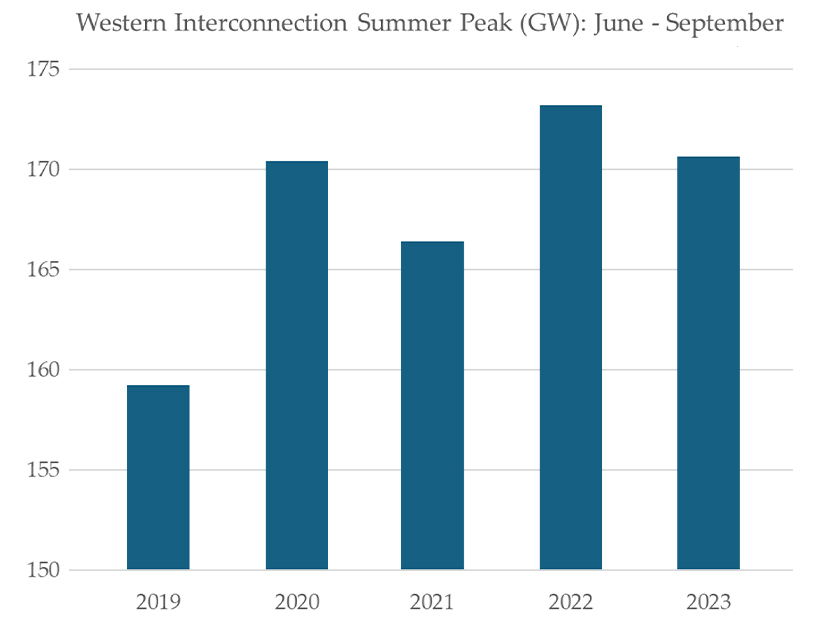
Extreme heat in the Desert Southwest and low hydro conditions the Northwest could pose reliability problems for the Western Interconnection this summer, although the region isn’t at an alarming risk for grid emergencies, WECC officials said during a June 5 call.
Those officials delved into the regional entity’s findings that became part of NERC’s 2024 Summer Reliability Assessment, which showed British Columbia, the Southwest and Baja California at an “elevated” — but not “high” — risk this summer, which indicates a “potential for insufficient operating reserves in extreme conditions.” (See NERC Summer Assessment Sees Some Risk in Extreme Heat Waves.)
Despite that assessment, Kris Raper, WECC vice president of strategic engagement and external affairs, cautioned call listeners about how quickly conditions could deteriorate, noting industry participants know the West has “had some really tight summers recently.”
“Until we can get more resources and more transmission online to be able to get the energy from where it’s generated to load and have a broader perspective and purview of where that energy can come from, then we have to know what it is that we’re looking at and what the risks may be,” Raper said. “And right now, the risks are greater than they’ve ever been.”
A trend of rising temperatures and an increased rate of load growth has fueled steady increases in summer peak demand in the West in recent years, and this year is expected to be no different, WECC officials said.
Data from the National Center for Environmental Information indicates a 61% chance that 2024 will be the hottest year on record and a 100% chance it will be in the top five, said Matt Zapotocky, senior reliability assessments engineer at WECC.
Investing in additional capacity is crucial to accommodating the increasing frequency of heat waves, Zapotocky said. Inverter-based resources (IBRs), which include renewables and battery storage, make up the bulk of capacity additions in the Western Interconnection, with the latter increasing “exponentially” between 2019 and 2023, from 230 MW to almost 10 GW. Solar resources nearly doubled from 19 GW to 35 GW over that time, and wind resources increased from 25 GW to 37 GW.
An additional 32 GW of proposed capacity is projected in 2024, with about 80% of that being IBRs. WECC also expects 1.6 GW of mostly thermal resources to be retired.
While no Western regions are projected to experience a loss-of-load event this summer, according to WECC’s assessment, some regions, such as British Columbia, are at a greater risk than others.
While hydroelectric resources and reservoir levels — particularly in California — are in a better position than they’ve been in the recent past, conditions have not returned to historical norms, said Bryon Domgaard, a senior analyst at WECC. Drought remains in British Columbia, where hydro resources make up 90% of the resource portfolio. Additionally, the province is undergoing rapid electrification in the industrial, commercial and residential sectors, but there are no planned capacity additions for the summer ahead, he noted.
“That reduction in hydro availability is really what is concerning for British Columbia. In addition, the transfer capacity has been diminishing over the past couple years as we see more load growth in the Pacific Northwest taking out some of the transfers that used to make it to British Columbia,” Zapotocky said. “These concerns, coupled with the increase in demand in British Columbia from electrification, placed it in that elevated risk category.”
The Desert Southwest also sees elevated risk because of heat-related extreme weather. The potential for high temperatures to cause derates for natural gas-fired generators coupled with escalating demand could lead to loss of load, Zapotocky said.
In California and Mexico, supply chain issues for obtaining grid equipment are of greater concern.
“Not being able to complete their projects on time could result in escalating the small amount of loss-of-load hours that we’re seeing in that region,” Zapotocky said. “Which reliability risk is most pertinent depends on which region we’re discussing.”
While increased coordination continues to be crucial for mitigating risk, interconnectivity in the system also adds new complexities.
Solar proliferation in California and Mexico has boosted south-to-north transfers into the Northwest, causing concerns about hitting system operating limits on paths between the two regions, Zapotocky said. And despite seeing more transfers from California to the Northwest, fewer of the transfers are making it to Canada. As British Columbia is forced to serve more of its own load, the system in other regions, such as Alberta, can experience reduced transfer capability.
“When it’s near islanding conditions — when IBR outputs are high and demand is low — there’s actually difficulty maintaining frequency response in that region, and this can potentially result in additional under-frequency load shedding. So really, everything is kind of interrelated here,” Zapotocky said.
With the influx of IBRs, areas in the Desert Southwest also are experiencing increased frequency issues.
Working Together
Demand response programs have been “instrumental” in reducing peak demand during stressed grid conditions, Domgaard said. But they face limits because of decreased customer participation in the face of increased DR events, and they should be reserved for emergencies.
Working together remains the priority in ensuring reliability across the Western Interconnection, said Katie Rogers, WECC manager of reliability systems.
“If there are wildfires going on in California, if there’s a drought that’s affecting hydro availability up in the north, how can the subregions and [balancing authorities] in the whole of the Western Interconnection work together so that someone isn’t stranded?”

